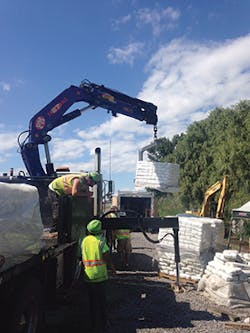Project Profile: Trenchless Repair of Elliptical Culverts in New York
The New York State Department of Transportation (NYSDOT) has successfully rehabilitated multiple failing culverts with a trenchless, centrifugally cast concrete pipe (CCCP) solution. Having completed several pilot projects—and specifying the solution for an emergency rehabilitation of a 300-foot, 36-inch corrugated metal pipe (CMP) culvert running under six lanes of Interstate 684, which connects Connecticut with New York City—NYSDOT again looked to the trenchless solution when similar work was needed in Seneca and Onondaga Counties.
The size and scope of the latest culvert rehabilitation project marked a significant milestone. Out of dozens of large culvert projects identified for restoration, five were awarded to Arold Construction Company as a subcontractor in a standard bid process. Vice president Ryan Arold (who also performed the I-684 work) says, “We’ve been doing CentriPipe projects since 2011, mostly municipal and some for NYSDOT, and I think we’re at the point where it’s recognized that this really is the right technology for many large-diameter culvert and sewer rehabilitations. We’re excited to be taking on more and bigger projects.”
This is Arold Construction’s largest CCCP contract to date, and one of the largest completed anywhere. Dimensions of the culverts are as follows:
- Site 1—500 feet of 8- by 6-foot elliptical CMP
- Site 3—200 feet of 6- by 4-foot elliptical CMP
- Site 5—50 feet of 6- by 4-foot elliptical CMP
- Site 6—50 feet of 6- by 4-foot elliptical CMP
- Site 10—200 feet of 5-foot CMP
All five culverts were in NYSDOT Region 3 (Syracuse area), and according to Arold, “These weren’t emergency repairs, but most of the culverts were in bad shape with rotted inverts and visible corrosion—I’d say they were near failure.”
Largest and Longest Ever
Clearly, site 1 is an outlier in the list above. At 500 feet, it’s a very long, very large culvert by any standard, running under several lanes of crowded interstate and a couple of frontage roads. It also features two approximately 40-degree bends at two large drop inlets in medians, ensuring a challenging project. “It isn’t the absolute longest CentriPipe project we’ve completed, but it’s close,” says Arold. “And it’s also one of the largest-diameter culverts we’ve ever worked on, making this the largest-volume project we’ve done to date.”
Arold says that the volume, the two bends, and other factors made this project a good fit for CCCP rehabilitation. “Practically speaking, the bends and size ruled out cured-in-place pipe [CIPP] and sliplining,” he explains. “And besides, the staging areas available were minimal—which also works against older methods. Honestly, without CentriPipe, I don’t know how this would have been done.”
Basically, only the medians and narrow shoulders, expanded with small temporary pads, were available for staging. “It was cramped,” he says. To help with logistics, the firm brought in a small truck crane capable of lifting material pallets, equipment, and even the pump trailer, and set them up to 70 feet away. The crane was brought in during mornings and evenings to set up and take down job sites in the median and on shoulders, without taking down guardrails or keeping other trucks onsite. It also eliminated forklift use—a good thing on highway projects.
The result is a monolithic, structurally sound concrete pipe cast within failing pipes, leaving no gaps or annular space between the new pipe and original substrates. The new pipe can be as thin as half an inch, which is useful where culvert capacity is an issue. Here, NYSDOT specified a total thickness of two inches over pipe corrugations. The thickness was verified by daily onsite inspection and by measuring internal pipe diameter after each pass.
Arold Construction Company also did structural repair on the two drop inlets feeding the culvert from the medians; these were large, 10- by 10-foot grates over 8-foot drops. PL-8,000 was still used in several thin layers, but was applied with a spraycaster. “We worked from the inside of the inlet and troweled after each layer,” explains Arold. “The results were excellent; the inlet walls were clean and smooth enough to look like new construction and were completely sound, structurally.”
Arold Construction Company was onsite for about seven weeks. The work on all five culvert sites was completed in under four months. No surprises were encountered: “Other than the sheer amount of work and the volume of the longest culvert, these were fairly routine projects.”
Arold says, “When we became licensed CentriPipe applicators in 2011, CCCP was still a relatively unknown solution in our region. So we were taking a chance. Now, it feels like it’s paying off.”
He says he expects more NYSDOT projects and municipal acceptance is already quite high, mainly due to lower costs associated with CentriPipe compared to CIPP. Perhaps best of all, an innovative, high-quality, and cost-effective solution is now available to address the infrastructure challenges that New York, like all states, is struggling to overcome.

